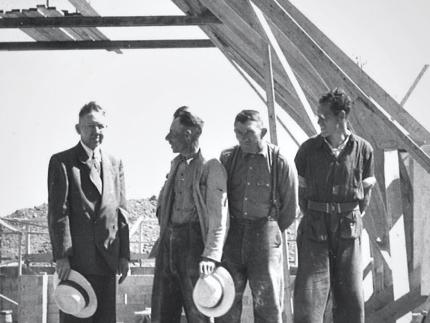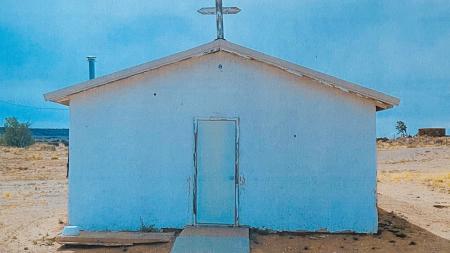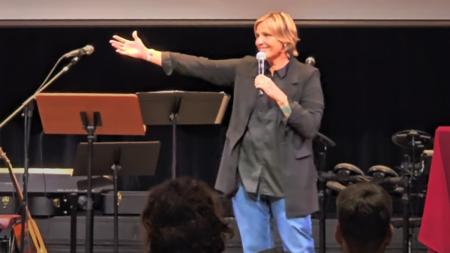Origins Online Aims for New Connections

Heritage Hall
A new blog is emerging at Heritage Hall, home of the archives of the Christian Reformed Church in North America at Calvin University in Grand Rapids, Mich.
Recently named curator of the archives, William Katerberg has helped to institute the blog as part of his vision for appreciating the past as the CRC’s story grows increasingly diverse today.
For starters, some of the stories in the new blog include his personal experiences in Dutch Reformed immigrant communities in Canada.
Titled “Origins Online,” the blog is an expansion of but not a replacement forOrigins, the semiannual magazine of the archives. Although he writes many of the blogs, said Katerberg, other authors contribute as well.
Until recently, Katerberg served as interim curator at the archives, which also house the historical records of Calvin University and Calvin Theological Seminary. But even before his appointment to serve permanently as curator, Katerberg began developing the blog as well as his vision for the archives’ future.
“I consider this blog as a way of connecting with our constituents — alumni, students, members of the CRC, and others — during a time when our links to the past are fraying and becoming more complex,” said Katerberg, who is also a professor of history at Calvin.
Katerberg said he would like the archives, as well the new blog, to be an ongoing resource for explanation, exploration, and education, especially for — but not limited to — members of the CRCNA.
“I’d like to see us think about how we in the present can connect to the past. I want us to think about who we are and where we come from. I want to tell stories and help other people to tell their own stories.”
While many of the stories that Katerberg and other authors have written in this blog have focused on the Dutch Reformed experience in North America, that doesn’t mean the blog is limited to that group of people.
Just as the CRCNA, along with the university and seminary, are becoming more diverse, it is important to make sure that stories that are shared reflect that reality. There have been stories on the blog about the church, Grand Rapids, and race relations; about Chinese American clergy, congregations, and members of the CRCNA; and about non-Dutch neighbors of CRC folk.
As the blog develops, he said, the goal is to tell a growing variety of stories about the history of the many communities that are part of the CRCNA.
An early blog post from Katerberg is a good example of the kinds of stories he hopes Heritage Hall can tell about the range of communities in the CRCNA. Focusing on the Dutch Reformed aspect of the church’s history, it features Frank Visscher, his grandfather, who emigrated with his family from the Netherlands in 1949.
“One of my aunts has been collecting material about our family history and about my grandfather — and I used that in writing the blog,” said Katerberg.
The story of Frank Visscher, said Katerberg, helps to illustrate the path taken by many immigrants from the Netherlands to Canada after World War II.
His grandfather, bolstered by his Reformed faith, wanted to bring his family to Canada because he saw the country as a land of opportunity, both in how he could express and live out his faith and in how Canada had plenty of farmland available on which he could settle.
Once Visscher arrived, he soon found and bought a farm in Drayton, Ont. Meanwhile, following his habits formed in the old country, he got involved in church and in civic life.
“My grandfather had been active in his church and in local politics in the Netherlands, and he did what came naturally to him in Drayton,” writes Katerberg in the blog.
The family arrived in March 1949, and by April, Visscher was connecting with other immigrants and helping them to make a new life in Canada. And along with the Van Elswyk and Van Heen families, he joined with Rev. Charles Spoelhof to begin worshiping in a home. “My grandfather read the sermon when Spoelhof could not be there,” he writes.
The small house church soon became First CRC in Drayton, and Visscher “was one of the first two elders, along with Gerrit Vander Heide.”
From that church eventually came several missionaries and pastors.
In this story, said Katerberg, you can read about how people new to a country find ways to feel that they belong.
Immigration and belonging are, in fact, topics he has written about in books that feature people from many backgrounds and ethnicities.
One of those books is titled Conquests and Consequences: The American West from Frontier to Region, which he coauthored with Carol Higham. The 475-page book offers a broad view of what happened when the Native American and European cultures came into contact as Europeans began to settle in the West.
He has also writtenImmigration Debates in America, which puts into context debates about immigration that have taken place in the United States going back 200 years.
Some parts of those larger stories are likely to find their way into the Heritage Hall blog as it evolves, said Katerberg. Both the blog and the Origins magazine focus on what people have experienced of the larger world around them. Katerberg’s stories about his experiences as an adolescent are good examples. They look at the traditions and practices that have helped people to express themselves and to maintain a sense of belonging.
For instance, in a blog titled “The Smells and Tastes of Being Dutch Reformed,” Katerberg asks readers to “imagine the sound of peppermints being passed around” when the sermon starts on a Sunday.
He goes on to recall memories like these: “Whispers. Paper being torn. And then the taste. Faam or King Peppermints. Lifesavers in a few families. For a long sermon, maybe you’d get a second or a third piece. Strong doctrine required strong peppermint.”
He also recalls how, in his experience, “faith had a Dutch brogue. I can still hear the accents of Scripture being read, hymns sung, prayers prayed, and sermons preached.” Then there was the aroma of authority, which “smelled like old cigars.” Also hanging sweet in his memory were oliebollen — “little homemade deep-fried Dutch donuts, with raisins or currents, or apples, made around New Year’s Day, eaten with icing sugar.”
Another recent blog looked at “The Flu Epidemic of 1918-19 and ‘Churchless Sunday.’” After giving a brief overview of ways in which the current, COVID-19 pandemic mirrors aspects of the flu outbreak of a century ago, this blog delves into the illness’s effects on the CRC.
For instance, Katerberg found an editorial in the Oct. 24, 1918, issue of The Banner that addressed the issue of the Michigan governor ordering all churches to close their doors to regular worship services.
The editorial, headlined “Churchless Sunday and Its Lessons,” called its readers, writes Katerberg, to “pray earnestly that the scourge [of the flu] may soon be removed” so that people could again “go to Sunday services.”
Katerberg also recounts how a church in Edgerton, Minn., offered this for a piece of news in The Banner: “The influenza played havoc with everything . . . in our village and vicinity. Churches, schools, movies, even pool rooms were promptly closed in the beginning of [the outbreak of] this dreaded disease.”
One new project the archives has undertaken is to seek and collect material and resources from CRCNA members and congregations about how they have responded to and been affected by the current COVID-19 pandemic. A recent blog post introduces the archive and includes a link to the portal where you can upload your story.
Above all, said Katerberg, his hope in writing the blog is to encourage others to consider their own heritage, be it Dutch, Asian, Native American, African American, Hispanic, or other — and all of these groups are being increasingly represented in the CRCNA.
History is precious, and our stories feel sacred. They help us know who we were and who we are, and they help us sort out who we want to be. It is about the movement of people from one place to another, seeking a home, security, and a sense of belonging.
History is also about sharing stories — but not just for the sake of telling a story.
“As a historian, I often think about how I can incorporate the voices of people long ignored, even suppressed,” Katerberg writes in one blog. “It’s not enough to simply add new voices but do nothing about the larger story. Inclusion begins to happen and things get more interesting when you also think together about how the larger story might and should change.”


